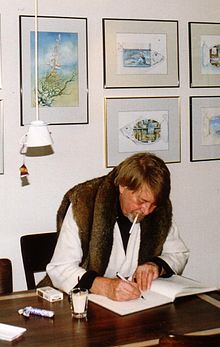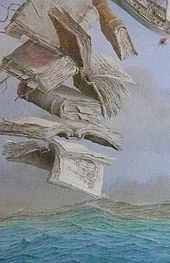Hans-Peter Wirsing
Hans-Peter Wirsing (born February 11, 1938 in Glückstadt ; † October 9, 2009 ibid) was a German painter and graphic artist who mainly depicted maritime subjects in the style of fantastic realism .
life and work
Wirsing studied commercial graphics from 1956 to 1961 at the art school in Hamburg on Alsterdamm . After graduating, he worked in advertising and for magazines as an illustrator, including for Stern and Zeitmagazin , and from 1978 as a freelance artist.
In 1972 he traveled to Vietnam and Cambodia during the war, and to Israel in 1976 .
In the 80s he made sailing trips in the Caribbean ; He sailed and drew with artist friends Peter Gutsche, Werner Nöfer , Peter Tuma and Hannsjörg Voth on the ketch "Mallliouhana" between the Leeward Islands Anguilla, St.Martin, Saba, St.Eustatius, St.Kitts, Nevis, Montserrat, Antigua, Barbuda and St. Barths. An extensive sketchbook was created on this trip. The notes and drawings were drawn directly on transparencies and later printed as zinc lithographs by the Böer + Gutsche printing company in Hamburg and published as a book.
In the 1990s he worked more frequently in Sintra near Lisbon. His works have been shown in numerous exhibitions, including in Denver, Vancouver Island BC, Wellington (New Zealand), Lillesand (Norway), The Hague, Dachau. Despite his cosmopolitanism, he remained connected to his hometown Glückstadt, whose history and development he critically processed in his pictures and drawings.
The estate is administered by his longtime partner and artist friend, most recently his wife, Leonore Schröder in Glückstadt.
The main subject of his pictures was seafaring as a metaphor for the conquest of the world and its destruction by man. He placed apocalyptic horsemen at the side of the client for journeys of discovery, Heinrich the Seafarer . In his "mostly maritime" pictures (the title of almost all of his exhibitions) he shows the peacefully rippled or stormy sea and historic ships as a magnificent spectacle in which he sets signs of transience: wrecks, ruins, fish carcasses.
Since 1986 he has also created several tile pictures in the tradition of the Portuguese azulejos .
Artistic classification
Wirsing painted exactly like the old masters. Ship types, buildings, water and sky are realistic down to the last detail, just like his role model, the Dutch marine painter Willem van de Velde the Younger . He breaks through realism in different ways. Ships, buildings, fish fly and float, ghostly beings populate the scene, there are several levels that break through or overlap. Wirsing has correctly assigned himself to fantastic realism: “Everything in my pictures is real. The attraction lies in bringing this reality into new context. I mix times and locations and bring the hidden to the fore. "
Even if he was referred to in the press as “Saltwater Dalí ”, he cannot be assigned to surrealism in the narrower sense. The fantastic component of his pictures comes less from the unconscious than from a conscious and critical break in reality.
literature
- Peter Gutsche (ed.): "Sketches", notes and drawings about a sailing trip through the Caribbean by Peter Wirsing , Peter Gutsche, Werner Nöfer , Peter Tuma and Hannsjörg Voth , printer and publisher Böer + Gutsche, Hamburg 1980
- Catharina Berents (ed.): "Dreamed horizons, oceans and ships - graphics and painting by Hans-Peter Wirsing, 1938-2009". Detlefsen Museum in the Brockdorff Palais, Glückstadt 2011.
- Anna Brenken: "A beautiful horror - Hans-Peter Wirsing's visions of nature's shipwreck". Yachtwelt 1989, pp. 149-158.
- Ewald Christophers: "The lake belongs to his whole passion". Ostfriesland Magazin, October 1990, pp. 2–5.
- Hermann Degkwitz: "Hans-Peter Wirsing: Mostly Maritime". Steinburger Jahrbuch, Itzehoe 1987, pp. 139-141.
- Helmut Eichhorn: “Mostly maritime”. Ostfriesland Magazin, October 1990, pp. 9-13.
- Klaus Lange: “Personal things about HPW”. Lions Förderverein Glückstadt (ed.): "Hans-Peter Wirsing - Mostly Maritime Calendar 2012", PrePress Peter Gutsche GmbH, 2011.
- Boie Meyer-Friese: "The tile pictures by Peter Wirsing". Katrin Ewald (ed.), “Gasthaus Der kleine Heinrich 1988-2013”, Glückstadt 2013, pp. 72–79.
Individual evidence
- ^ "The painters of the north", "Artist biographies Hans-Peter Wirsing, Glückstädter Museumhefte, No. 12, on the special exhibition in the Detlefsen Museum Glückstadt, March 2009
- ^ Special print "Art in the power plant - Hans-Peter Wirsing - Mostly Maritime", published by the Brokdorf Information Center nuclear power plant, undated
- ↑ Ewald Christophers: "The lake belongs to his whole passion", p. 4.
- ↑ Regine Rübcke: "A little cynicism must be". Glückstädter Fortuna, November 28, 2005, p. 20
- ↑ Christine Reimers: “Glückstadt painter Wirsing died”. Glückstadt Fortuna, October 13, 2009
Web links
- Detlefsen Museum Glückstadt : The painter Hans-Peter Wirsing (accessed on May 27, 2015)
| personal data | |
|---|---|
| SURNAME | Savoy cabbage, Hans-Peter |
| BRIEF DESCRIPTION | German painter and graphic artist |
| DATE OF BIRTH | February 11, 1938 |
| PLACE OF BIRTH | Glückstadt |
| DATE OF DEATH | October 9, 2009 |
| Place of death | Glückstadt |


